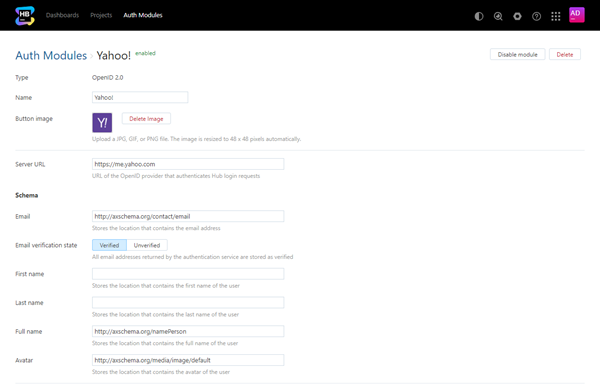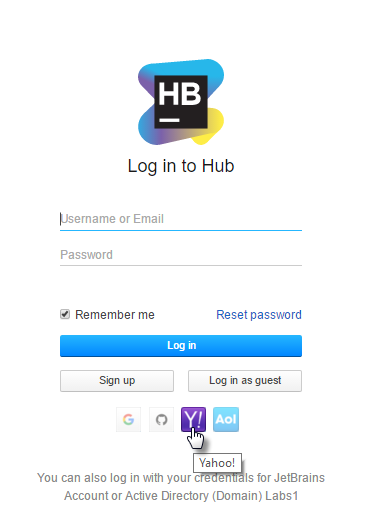Yahoo! Auth Module
This authentication module lets users log in to Hub with their Yahoo! accounts.
Enable Yahoo! Authentication
To allow users to sign in to Hub with their Yahoo! accounts, enable a Yahoo! authentication module.
To enable Yahoo! authentication:
In the Access Management section of the Administration menu, select .
From the Add Module drop-down list, select Yahoo (OpenID).
The Yahoo! authentication module is created, enabled, and configured automatically.
The Auth Modules page displays the settings for the Yahoo! authentication module. For additional information about the settings on this page, see Settings.

The icon stored in the Button Image setting is added to the login dialog window. Users can click this icon to authenticate with their Yahoo! accounts.

Settings
The settings are configured automatically when the module is added to Hub. You do not have to change these settings. To configure the options that define how Hub treats new user accounts with Yahoo! credentials, see Additional Settings.
Field | Description |
|---|---|
Type | Displays the name of the application or service that is enabled for third-party authentication in Hub. |
Name | Stores the name of the authentication module. Use this setting to distinguish this module from other authentication modules in the Auth Modules list. The name is also shown in the tooltip for the third-party service icon on the login form. |
Button image | Displays the image used for the button that a user clicks to log in to Hub with a their account in the connected authorization service. You can upload a JPG, GIF or PNG file. The image is resized to 48 x 48 pixels automatically. |
Server URL | Stores the URL used to authenticate a login request in Hub. |
Schema
Use the following settings to map user data stored in Yahoo! to user accounts in Hub.
Field | Description |
|---|---|
Stores the location that contains the email address. | |
Email verification state | Determines which state should be set for an email address in Hub, when the authentication service does not return the verification status for an email address. |
First Name | Stores the location that contains the first name of the user. |
Last Name | Stores the location that contains the last name of the user. |
Full Name | Stores the location that contains the full name of the user. |
Avatar | Stores the location that contains the avatar of the user. |
Additional Settings
When a user logs in to Hub with an Yahoo! account for the first time, Hub checks if an account with the same email address exists. If an account with the same email address exists, the Yahoo! credentials are added to the existing account.
Use the following settings to configure how Hub manages user accounts. These settings also let you reduce the loss of processing resources consumed by idle connections.
Option | Description |
|---|---|
User creation | Enables creation of Hub accounts for unregistered users who log in with an account that is stored in the connected authorization service. Hub uses the email address to determine whether the user has an existing account. |
Auto-join groups | Adds users to a group when they log in with an account that is stored in the connected authorization service. You can select one or more groups. New users that auto-join a group inherit all of the permissions assigned to this group. |
Connection timeout | Sets the period of time to wait to establish a connection to the authorization service. The default setting is 5000 milliseconds (5 seconds). |
Read timeout | Sets the period of time to wait to read and retrieve user profile data from the authorization service. The default setting is 5000 milliseconds (5 seconds). |
Audit | Links to the Audit Events page in Hub. There, you can view a list of changes that were applied to this authentication module. |